The geographic distribution of health problems and its relationship to potential risk factors has opened a vast field for epidemiological research. The present study aims to identify spatial distribution patterns for the neonatal and post-neonatal components of the infant mortality rate (IMR) in Ceará State, Brazil, and discuss the main socioeconomic, demographic, and healthcare factors contributing to the spatial dependence of these components. This cross-sectional ecological study uses multiple linear regression, in which spatial analysis of the components was obtained through the Moran index. Prenatal, childbirth, and neonatal care as well as improved income distribution are decisive for survival in the first month of life, while other factors related to nutrition, immunization, sanitation, education, and economic status are possible determinants of post-neonatal mortality. Selective healthcare measures are known to play a decisive role in decreasing the IMR. However, structural and inter-sector changes generate the sustainability needed to maintain this indicator on the same level as in developed countries.
Residence Characteristics; Infant Mortality; Epidemiologic Factors





